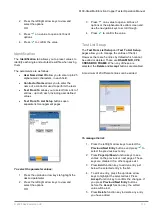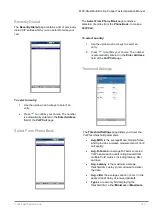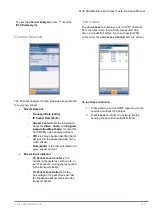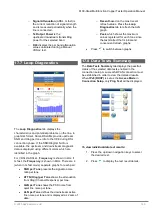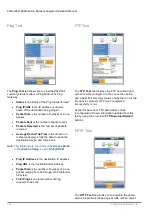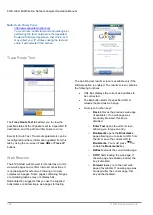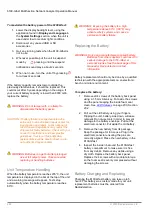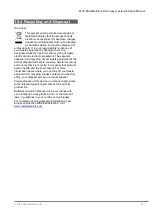
6100-Gfast Multifunction Network Analyzer Operation Manual
186
© 2020 Radiodetection Ltd
DSL Parameter Details
The
DSL Param Details
tab displays the
Downstream
and
Upstream
parameter results
configured in the DSL/IP tests.
When the
Test Interface
for
Auto Test
or
Manual
Test
is set to ADSL2+ or VDSL2 bonding mode, there
will be 2 pages of results, one for each DSL line-pair.
To access the second-pair results, press the
Pair 1
/
2
function key at the bottom-right of
the screen.
Line Status
displays the status of the line
under test during negotiation with the DSLAM.
The value changes from Idle /Activate
/Handshake /Training /Show Time for DSL
mode.
Note: When loading firmware into the Broadcom
chipset, the
Line Status
value displays
Loading
M:SS
, where M:SS is a countdown timer.
Operation Mode
is the DSL mode of operation
as negotiated between the unit and the
DSLAM.
CO Vendor ID/Version
is a unique 4-digit
alphanumeric identifier of the DSL chipset
manufacturer, used on the CO (central office)
side, and its version number.
CO Version
is the version number of the
unique alphanumeric identifier of the DSL
chipset used on the CO side.
Sync loss count
is the number of times the
unit lost synchronization.
Power Save State
refers to the power-save
mode of the DPU (distribution point unit) and
displays one of three states:
L0
(power full on),
L1
(low power), or
L2
(idle).
Parameter - Downstream/Upstream
o
Actual Data Rate
displays the values
at which the unit and CO are
connected, as negotiated during the
training phase. The values should
represent what the CO was set to,
unless the DSL link is being subjected
to high levels of noise/crosstalk.
o
SNR
is the signal-to-noise ratio margin
measured on the line.
o
Attenuation
is line attenuation
measured during the training phase.
Note:
DSL Param Details
displays
Attenuation
for
ADSL1/2/2+ and G.fast. See
Band Information
for VDSL2 attenuation.
Capacity
is the capacity of the line as a ratio of
achieved bit rate over the maximum attainable
bit rate presented as a percentage (%). A high
value could mean that the link is nearing its
maximum capabilities while a low value could
mean the link is being under-utilized
(sometimes intentionally
– verify your local
DSLAM setup).
Maximum Data
Rate displays the maximum
attainable bit rates that the circuit can handle
as determined by the remote terminal and CO
during the training phase. Values can be
greater than the actual bit rate.
Output Power
is the current transmit power
level that is a measure of the aggregated
transmit power.
Latency
is the path type, Fast or Interleave,
set by the service provider at the CO. The use
of the interleaved path means greater delay in
the delivery of data but it is less susceptible to
noise or crosstalk due to increased Reed-
Solomon coding and FEC (forward error
checking). The use of the fast path means little
or no delay in the delivery of data but it is more
susceptible to noise and crosstalk.
Interleave Delay
defines the mapping (relative
spacing) between subsequent input bytes at
the interleave input and their placement in the
bit stream at the interleave output.
INP
is the level of impulse noise protection.
Interleave Depth
defines the number of bits
(or bytes) in each block of data.


